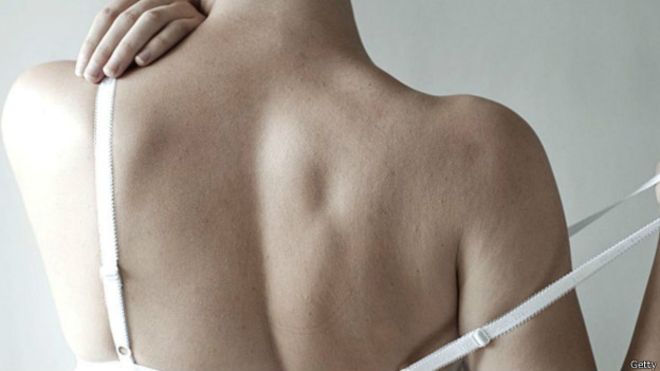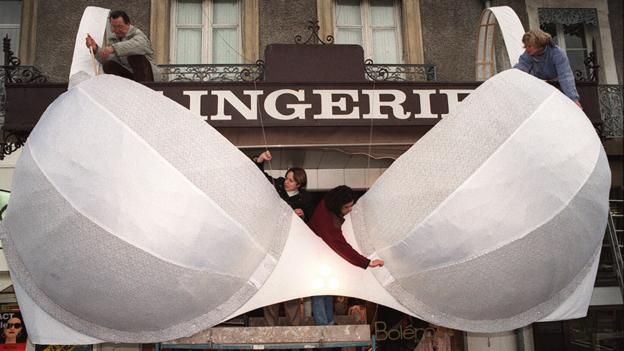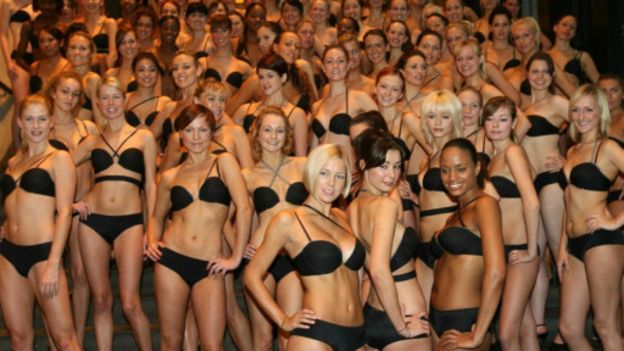令人心神振奋的文胸历史
BBC卡佳·福尔曼 (Katya Foreman)(2023年11月4日)

有趣的是,时尚内衣女王尚塔尔·汤玛斯(Chantal Thomass)早期其实是反对穿戴文胸的。随着社会环境、时尚以及人们对女性身体看法的不断改变,这种时尚内衣在近几十年中的受欢迎程度也起伏不定。
“20世纪60年代女权主义出现,我们甩开了身上的文胸。而嬉皮士时代,我们在T恤里面什么也不穿,去沙滩的时候也赤裸着上身。如今再没有女性赤裸上身在沙滩漫步了!”这位 70 年代把内衣当作时尚单品的先锋,带着一抹标志性红唇和黑色波波头的法国设计师说道,“当年,我让模特们穿着文胸走上时装周的 T 型台,于是文胸就火了。”
当时,只有在巴黎的红灯区皮加勒(Pigalle)才能找到像吊袜带和半罩式文胸一类的性感内衣,“用的是低劣面料”。那时的人们认为内衣只是功能性的,汤玛斯说,她过去的设计灵感来自更为女性化的时代,比如精致的平面风格就源于上世纪20年代和30年代“精致的配色、面料和刺绣”。
“那时候还有纯手工制作的精美内衣,现在就太贵了,”这位将“支撑胸部”和打扮、展现胸部的传统视作“文化遗产一部分”的设计师感叹道。“欧洲的传统可以追溯到中世纪时期,尽管支撑胸部的程度各不相同,但这项传统一直是我们文化中的一部分。”
汤玛斯告诉BBC Cultures栏目,“真正让人触动的是我去亚洲旅行的时候,发现那里并没有文胸一说,她们对内衣是那样的着迷。20世纪的亚洲女性仍然用[布带缠绕]她们的胸部;她们从未穿过文胸,对于她们来说,文胸完全是个新事物。”
“Bra”(文胸)一词是法语单词brassiere的缩写,字面意思是“女式紧身上衣,儿童背心”,制作过程非常复杂。早期设计的文胸是笨重而又复杂的奇品,还被称为“巨石容器”(借用了贝特·迈德尔(Bette Midler)带有讽刺意味的歌曲《奥托·提斯林》(Otto Titsling)中的"boulder holders"一词),与如今高雅、高科技、高弹性的文胸相去甚远。
《美国的文胸史:上托的革命》(Uplift: The Bra in America )一书中,有一段话描绘了上世纪30年代(文胸大批量生产的年代)的场景:“那些成年顾客以及因胸部过大而造成下垂的各年龄阶段女性,终于可以买到围度更长、有拼接衬垫、罩杯下有结实护带、罩杯间有楔形嵌入布条、束带宽大有弹力、骨质轻盈的文胸。”

很难查出文胸第一次出现是什么时候,而关于类似文胸服饰的早期描述,还要追溯到古希腊时期(图片来源:Getty Images)
这本书很厚重,其中还写道,SH Camp and Company公司率先采用了字母A至D来表示文胸的尺寸和罩杯(现在已经扩展E、F、G 等杯罩了)。在这之前,“市面上长久以来都是采用可伸缩罩杯以适应大小不同的胸部”。
“文胸由很多小布块拼接而成,是一种对技术要求很高的服饰,同时还需要设计不同尺码以适应不同的罩杯大小,等等。文胸也是一种要求勤换勤洗的服饰,所以对缝接和构造的要求也很高。文胸和普通衣物十分不同;与肌肤直接接触,同时需要非常结实。”
汤玛斯回想起莱卡(Lycra)给这个行业带来的影响(上世纪80年代受莱卡的影响很大),接着解释道,“莱卡这种材质让文胸变得更加舒适,也给设计带来了新的可能。我过去一直很喜欢在内衣上印上瓦格斯(Vargas)的画,看起来就像是女性的第二层肌肤。是莱卡出现之后我们才得以将这种想法实现的。”
很难查出文胸第一次出现是什么时候,而关于类似文胸的服饰的早期描述,还要追溯到古希腊时期。现代社会的文胸通常都被视作紧身胸衣的继承,然而这种说法有时也会受到挑战。2008年在澳大利亚一座城堡的挖掘过程中,考古学家们发掘出四件破碎的文胸,与现代内衣的外形极其相似。于是引发了“先有内衣还是先有文胸”的争论。
“进化有时候会停滞不前。”澳大利亚因斯布鲁克大学的一位考古学家和研究员比阿特丽克斯·纳兹(Beatrix Nutz)在smithsonianmag.com网站上发表的一篇文章论说道,“希腊数学家和地理学家埃拉托色尼(Eratosthenes)(公元前276~195年)当时就已经知道我们的地球是一个球体,甚至还计算出了它的周长。但是在整个中世纪,人们却认为地球是平的。
当然,就重要性而言,文胸与地球的实际形状相比是非常微不足道的,但很显然早期确实有人发明了文胸,然后过时了,接着被人们抛在脑后,而在19世纪末期得以(重新)发明。”纳兹还引用了两处文献记载,提到了可以看做是早期文胸的衣物。
“法国 13 世纪一位名叫亨利·曼德维尔(Henri de Mondeville)(1260-1320)的外科医生曾发表过一篇报告,谈及当时胸部过大女性的应对办法:‘她们往衣服里塞入两个袋子,根据胸部调整并收紧,每天早上把胸部放入袋子里,再用调整带系紧,’”“15世纪一位不知姓名的德国诗人在一首带有讽刺意味的诗中写下了这样的句子:‘漫步在街上的女人,戴着她们手工制成的胸袋,如此,朝她们打望的年轻男子,眼光停留在了她们美丽的胸部。’”

世界上最大的文胸,由劳伦斯·比伦 (Laurence Billon) 设计(图片来源:Pierre Boussel/AFP/Getty Images)
D罩杯风暴
科琳·希尔(Colleen Hill)是时装技术学院博物馆副馆长,最近组织举办了一场名为“若隐若现:内衣发展史”的展览。她说,卡多尔 (Cadolle) 作为法国历史最久的内衣品牌之一,“向大众引入了我们今天所了解的文胸,无疑是颇具影响力的”。而在其网站上,这家品牌也将文胸的发明归功于品牌的创始人赫米尼·卡多尔(Herminie Cadolle),称她是一位“女权主义者和革命者”。“在19世纪末期的美好时代,她想要将女性的身体从紧身胸衣中解放出来……她当时设计出的样式是如此小巧,已然就是现在的文胸。”
1889年问世的文胸,实质上是一件两片式紧身胸衣,“它带来了稍微多一些的活动空间。”希尔解释道,“到了20世纪早期,文胸的发展也和女性发挥了更多职能息息相关;丢掉紧身胸衣,选择更有弹性的紧身褡或文胸,不仅会让你的身体线条更为现代,还会带给你更大的灵活性,更多的活动空间,以及更加现代的生活方式。”
在所有最具变革性的文胸当中,希尔特别提到了时尚设计师鲁迪·吉恩里希(Rudi Gernreich)的发布于1964年的“隐形文胸”设计。这是第一款极简主义文胸,非结构化设计彻底告别了1950年代沉重的鱼雷式文胸。然而在研究吉恩里希展演的同时,希尔发现了一个更早的例子。
“我当时正在浏览1940年代一本关于紧身胸衣、文胸和内衣的商业杂志,然后我发现了一种用透明衣料制作的文胸。”她回忆道,“它之所以能让我在内容繁多的杂志里,从密集的文字和插图中一眼看到,是因为该杂志的创始主编在这幅插图上画了一个圈,接着又画了条线一直连到那一页顶部的两个字:‘恶心!’。”
“我之前曾经研究过鲁迪·吉恩里希的‘隐形文胸’,以及这种文胸获得如此成功以及高销量的原因。隐形文胸影响之大,风靡了上世纪70年代,甚至今天也还能见到它的身影。很显然人们在60年代就已经准备好接受这种风格了,但是在40年代还尚未准备好……这确实与人们对女性身体的接受程度有关。”

视觉游戏
30年后,麦当娜用自己的行动为文胸正名,用锥形文胸表达她对女性特征及女性权利的见解(尽管女权主义者曾认为文胸象征着束缚而加以抵制)。在她名为“金发雄心世界巡回演唱会”中,这位歌手身着由让·保罗·高缇耶(Jean Paul Gaultier)(这位设计师在他的创作生涯中最喜欢玩的概念就是内衣外穿)设计、带有锥子形文胸的紧身胸衣。“锥形文胸充满挑衅意味,同时又十分性感、有趣。”
希尔说道,“我惊喜地发现,高缇耶在紧身胸衣、束腰带上的兴趣与他童年的经历其实有着千丝万缕的联系。在他小时候,女性其实已经不穿这种紧身打底内衣了,当他在祖母的衣柜里发现这些衣物的时候,只觉得过时而又奇怪。而最后他将这些内衣变为时尚单品的想法实在很有意思。”
同样,在1994年,神奇文胸(Wonderbra)品牌推出的由艾伦·冯恩沃斯(Ellen von Unwerth)拍摄、爱娃·赫兹高娃(Eva Herzigova)主演的“你好男孩”(Hello Boys)广告引起了不小争议。广告中,爱娃穿着带有内垫和钢丝的文胸,乳沟惊现。该广告传达了一种希望女性接受自己性别特征的理念。《标准晚报》曾报道,这位捷克籍的模特一直坚称这项活动旨在“增强女性自主权”。
在希尔看来,不论是反对还是支持,女权主义和烧毁文胸行为之间的联系有些难以理解。“这又让人回想到了1968年反对美国小姐大赛的抗议活动。
当时反对美国小姐选美大赛的女性们向所谓的“自由垃圾桶”之中扔了许多东西;扔掉的不仅仅是文胸和束腰带(尽管它们是通向自由之路上的成果),还有高跟鞋、化妆品和女性杂志。
当然,并没有真的点火把它们烧光。在我看来,历史中总有这样的人,他们宣称已经烧毁了某些东西,而大多数人都认为这种行为只是象征性的‘烧毁’。”比如汤玛斯,一开始她为了不穿文胸的自由而雀跃欢呼,最后又将穿着内衣视为绝对女性的标志。人的个性和表达总是千变万化,人们对文胸的感知变化也不会停息。
(责编:友义)
The bra: An uplifting tale
By Katya Foreman,4 November 2024
It’s amusing to think that in her youth, lingerie queen Chantal Thomass was anti-bra. It’s an undergarment that over the decades has fallen in and out of favour in line with changing social contexts, fashions and views on the female body. “With the advent of feminism in the 1960s we removed our bras. It was the hippie period and we’d wear T-shirts with nothing underneath, and go topless on the beach. Nobody goes topless on the beach anymore!” says the iconic red-lipped, black-bobbed French designer who in the ‘70s pioneered the concept of lingerie as a fashion accessory. “I put it on the catwalk during fashion week and that’s how it took off.”
At the time, the only place one could find sexy lingerie like garters and balcony bras was in Pigalle, Paris’s red light district, “in tacky fabrics”. Lingerie was considered functional, says Thomass, whose archive features designs from more feminine periods, such as delicate, flat styles from the 1920s and ‘30s in “exquisite colour mixes, fabrics and embroideries”. “Back then you could do beautiful handmade designs, today it’s too expensive,” laments the designer who regards the tradition of “breast support” and dressing or showcasing the breasts as “part of our patrimony”. “In Europe the tradition stretches back to the Middle Ages, though to varying degrees – supporting the breasts, for sure, has always been part of our culture,” Thomass tells BBC Culture. “It only really hits me when I travel to Asia where they have no bra culture, and see how fascinated they are by the undergarment. In the 19th Century in Asia women still [wrapped fabric around] their breasts; they have never worn bras, it’s completely new over there.”
The bra – short for the French word brassiere, literally 'bodice, child's vest' – is complex in fabrication. Early designs – often bulky, elaborate contraptions, or “boulder holders”, to borrow a phrase from Bette Midler’s satirical song Otto Titsling – were worlds away from today’s sophisticated, high-tech, high-stretch bras. An excerpt from the book Uplift: The Bra in America describes the scene back in the 1930s, the decade in which the large-scale production of bras began. “Mature customers and women of all ages with large pendulous breasts were offered long-line brassieres, built-up backs, firm bands under the cup, wedge-shaped inserts of cloth between the cups, wide straps, power Lastex and light boning.” According to the tome, it was SH Camp and Company that pioneered the chart relating the “size and pendulousness” of breasts to letters of the alphabet, A to D (a scale that today stretches to infinity). Prior to that, “companies had relied on stretchable cups to accommodate different depths of breast”.
“It’s a highly technical garment, made of lots of tiny pieces of fabric, with so many sizes to consider for the different cups, etc. It’s a garment you wash every day, so the seams and structure need to be extremely robust. It’s very different from a piece of clothing; it’s in direct contact with the skin, it needs to be super solid,” Thomass explains, who recalls the impact Lycra had on the industry when it became big in the 1980s. “It brought new comfort and design possibilities. I had always loved Vargas’s paintings of pin-ups in underwear as the pieces looked like second skin and we were only able to do that when Lycra came along.”
It’s impossible to pinpoint when the bra was first invented, with early depictions of bra-like garments going back all the way to ancient Greece. The modern-day bra has often been presented as a successor to the corset, though the theory is sometimes challenged. During a dig at an Austrian castle in 2008, archaeologists unearthed four tattered bras remarkably similar to the undergarment’s modern form. A chicken-or-the-egg-style debate ensued.
“Evolution sometimes takes a break,” argued Beatrix Nutz, an archaeologist and researcher at the University of Innsbruck in Austria, in smithsonianmag.com. “The Greek mathematician and geographer Eratosthenes (276 BC–195 BC) knew our planet was a globe and even calculated its circumference, but throughout the Middle Ages people believed it to be a flat disc. Bras are certainly not even remotely as important as the actual shape of the earth, but they were obviously invented, went out of fashion, were forgotten, and supposed to be invented (again) in the late 19th Century.” Nutz also cited two earlier written sources referencing what could be perceived as early versions of the bra. “The French surgeon Henri de Mondeville (1260-1320) reported what women whose breasts were too large did. They ‘insert two bags in their dresses, adjusted to the breasts, fitting tight, and put them into them every morning and fasten them when possible with a matching band,’” she said, adding: “An unknown German poet of the 15th Century wrote in his satirical poem, ‘Many make two breastbags, with them she roams the streets, so that all the young men that look at her, can see her beautiful breasts.”
Storm in a D-cup
According to Colleen Hill, associate curator, accessories, at The Museum at the Fashion Institute of Technology, and organiser of the recent exhibition Exposed: A History of Lingerie, Cadolle, one of France’s oldest lingerie houses, was “certainly incredibly influential in introducing the bra as we know it today”. Indeed on its website the brand lays claim to the bra’s invention, attributing it to house founder Herminie Cadolle, “a feminist and revolutionary”. “At the end of the 19th Century, during the Belle Epoque, she chose to liberate women by liberating their bodies of the corset… She came up with this ever so small, tiny thing that today goes by the name of the bra.”
The bra in question, launched in 1889, was essentially a two-piece corset “which would have allowed for a little more freedom,” explains Hill. “As we move into the early 20th Century the bra very much corresponds to the idea of women leading more functional lives; if you’re abandoning your corset for perhaps a more flexible girdle and a separate bra, that’s something that’s not only giving you a more modern silhouette, it’s also certainly allowing you a lot more flexibility and movement and corresponds to a more modern lifestyle.”
Among the most revolutionary bras, Hill points to fashion designer Rudi Gernreich’s “no-bra” bra, launched in 1964. Billed as the first sheer bra, the minimalist, unstructured design was a radical departure from the heavy, torpedo-shaped brassieres of the 1950s. While researching her show however, Hill unearthed evidence of an earlier example. “I was going through a trade magazine from the late 1940s that was focused on corsets, bras and lingerie and I found a kind of early version of a bra made from see-through fabric,” she recalls. “And the reason it stood out from the text and all of the illustrations in this fairly dense magazine was that the original owner of the magazine had circled the illustration and drawn a line up to the top of the page and written ‘Disgusting!’.”
“I had researched previously Rudi Gernreich’s ‘no-bra’ bra, and how it was a success and sales for that bra were good, it made quite a big impact and you can see that very well into the 1970s, even today, so obviously people were ready for that style in the 1960s but not so much in the 1940s… It really was about making a statement about the acceptance of women’s bodies.”
Game of cones
Thirty years later, Madonna famously re-appropriated the bra – once rejected by feminists as a symbol of repression – to express her own statement on female sexuality and empowerment. On her Blonde Ambition World Tour, the singer sported corsets with exaggerated in-built conical bras by Jean Paul Gaultier who throughout his career has played on the concept of underwear as outerwear. “It’s provocative but it’s also really sexy and playful,” says Hill. “I loved reading about Gaultier’s interest in corsets and girdles and how that relates back to his childhood when women weren’t really wearing foundation garments like that and when he saw these pieces in his grandmother’s closet, he thought they looked so antiquated and strange. The idea of changing that into an item of fashion is really quite fun.”
Similarly, Wonderbra’s controversial 1994 Hello Boys advertising campaign, photographed by Ellen von Unwerth and starring Eva Herzigova, her cleavage thrust into view with aid from the bra’s padding and underwire construction, played on the idea of women embracing their sexuality. The Czech-born model insisted the campaign was “empowering”, according to a report in the Evening Standard.
Whether anti- or pro-bra, the popular association between feminism and the act of burning bras is a myth, according to Hill. “It relates back to the Miss America protest in 1968. The women who were protesting the Miss America Pageant had what they called a freedom trash can in which they threw a number of things; it wasn’t exclusively bras and girdles – though those made their way in – it was also high heeled shoes and cosmetics and women’s magazines. However there was no actual burning. I think there was one person in all of history who claimed, yes, they burned them but most people say it was more of a symbolic burning; it was throwing all these things into the trash can but, because of fire codes, nothing was actually burned.” Like Thomass, who started out celebrating the freedom of going braless and ended up embracing the undergarment as the symbol of absolute femininity, perceptions continue to shift about this ever-evolving design with multiple personalities and expressions.